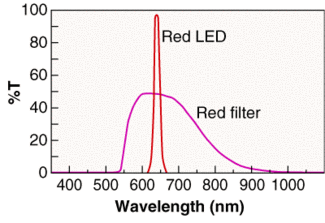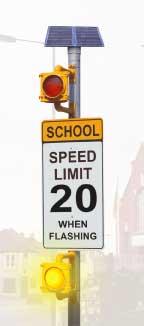Light-emitting diodes (LEDs) have become remarkably effective light sources and they have been getting a lot of press lately. While they are wonderful devices and deserve recognition, they are not without their flaws. Our company designs lighting products based exclusively on LEDs for a broad range of industries. Based on this experience we can provide a long-term user’s perspective on the “vices” and “virtues” of LED technology.
 |
| FIGURE 1. Multiple LEDs, which are unlikely to fit into existing lamp housings, are required to make a 360° light source. |
The LED families
We are all accustomed to buying a standard white light bulb and putting it behind a lens to produce the beam pattern and color we desire. Need a different color or beam pattern? Change the lens, and everything else stays the same – LEDs aren’t like that.
The starting point is to recognize that there are, in fact, three main families of LEDs: red- and yellow-emitting devices arising from aluminum indium gallium phosphide (AlInGaP) technology, green- and blue-emitters based on indium gallium nitride (InGaN) technology, and white-light LEDs that use InGaN plus phosphors.
One must be careful about making generalizations about LEDs. The InGaN and the InGaN-plus-phosphor families, for example, differ significantly in their efficiency and lifetimes, while the AlInGaP and InGaN families run on quite different voltages. Keeping family differences in mind, however, several generalizations can be made about using LEDs, both negative and positive.
The “vices” of LEDs
Several factors combine to slow adoption of LEDs in the marketplace. These include compatibility with existing and so on. In fact, the weakest link in LED lighting systems is the electronic drive circuitry, not the LEDs.
 |
The white-light challenge. Most lighting applications require white light. Unfortunately, LEDs naturally produce a pure color, so making white light is not their forte. Light-emitting diodes must resort to using phosphors, which convert some or all of the pure blue or ultraviolet (UV) light from an LED dye into different wavelengths that appear to the eye as white light. In lumens per dollar, white LEDs are still a hundred times more expensive than incandescent lights and their efficiencies are well below that for color LEDs because of the losses involved in the energy conversion step with the phosphor. The color rendering index (CRI) is not great either, meaning that the light produced is not a very pleasing form of white light. The difficulties that LEDs have with producing white light have dramatically affected how quickly LEDs have been adopted into lighting applications (see table).
The “virtues” of LEDs
So far we have focused on the challenges of lighting design with LEDs because these challenges are often glossed over. Nonetheless, LEDs do have some significant virtues. From a vibration and shock point of view, for example, LEDs are virtually indestructible. This characteristic is hugely important for the vehicle industry and for applications in which vandalism is a factor. In terms of size, the actual light source in LEDs is vanishingly small. This small form-factor allows for new lighting applications such as more distributed interior lights in cars, and edge-lighting of signage.
Because LEDs give off a relatively small amount of heat, they can be completely sealed in lenses and lamp housings, making for more durable and weather-tight lamps. They operate on low-voltage DC current, which makes LEDs ideal for battery and solar applications, such as flashlights and garden lights.
For colored LEDs, the lifetime as measured by mean time between failure (MTBF) is extraordinary. Although MTBF varies with temperature, typical MTBFs for red LEDs are measured in millions of hours. In comparison, incandescent bulbs range from 1000 to 5000 hours.
 |
| FIGURE 4. The spectrum of a red LED (AlInGaP) compared with a red-filtered incandescent light source shows greater color purity and brightness. |
Light-emitting diodes are very responsive and turn on and off instantaneously. This allows microprocessor control, dimming, exact flash patterns, strobing, encoding, and higher effective intensity when flashing. These devices are also far more efficient at producing colored light than are incandescent bulbs with a filter. Red LEDs easily produce 30 lumens/W, for example, while incandescent bulbs with a filter produce, at best, 5 lumens/W (see Fig. 3). And, finally, the colored light produced by LEDs is purer and more penetrating than conventional filtered incandescent light (see Fig. 4).
Applications
One might think that the main market for a radical new light source would be illumination. But for LEDs, because of their peculiarities, this is not the case. The high-brightness LED market has grown from $300 million in 1997 to $1.8 billion in 2002, almost all in specialty applications, not general illumination.
The biggest market for LEDs is currently backlighting of LCD displays in mobile phones, PDAs, and digital cameras where LEDs are valued for their low power consumption, robustness, and small size. This application represented 30% of the total LED market in 2001. For similar reasons, LEDs are now used extensively for interior and exterior lighting applications in cars, trucks, and buses, with this being the second largest market segment.
The third major market for LEDs is less conventional – they are used as “pixels” in large sign displays, including signs based on monochromatic displays for moving messages, and full-color displays for large video screens. Since LEDs are so small, they are also used for edge lighting of conventional signage (rather than back lighting or front lighting).
For indicator lights in electronic equipment, LEDs long ago replaced the competition because of their durability and low power consumption, although this is not a major market in terms of revenue.
Signal lights, such as railway, navigation, and traffic lights, are usually colored, which plays to LEDs strengths. In traffic lights, for example, the energy saving is more than enough to repay the capital costs. Reduced maintenance offered by the long-lived LEDs then becomes the up side to the consumer, and the overall value proposition is compelling. Use in traffic signals was one of the fastest growing LED applications in 2002, growing at a rate in excess of 100%. The penetration of LEDs into this market is quite high, but the overall market size is relatively small.
While, LEDs have almost no market penetration to date of the huge general illumination market, they have begun appearing in niche markets such as bus shelters and park lights where maintenance is expensive and where LEDs can withstand the elements and vandalism more effectively than conventional light sources.
 |
| FIGURE 5. Solar-powered LED lighting appears to be the largest entirely new market enabled by high-brightness LED technology. |
Their unique attributes make LEDs particularly suitable for solar power, which has led to the emergence of new products that allow lighting to be completely independent of the electricity grid. These products include solar-powered garden, highway, navigation, and aviation lights (see Fig. 5).
Prognosis
As a light source, the rate of improvement of LEDs far exceeds improvement rates in conventional light sources. As the price/performance ratio of LEDs continues to improve, the number of niches in which they offer a good value proposition will continue to multiply. Light emitting diodes will advance from the fringes of the market to center stage. This advance may take place first where there is no existing infrastructure, such as in rural locations, and in the Third World where kerosene is still the primary light source. With time, LEDs will also penetrate the existing infrastructure and become the light source of choice. Eventually the widely anticipated LED “revolution'”really will occur.
REFERENCE
Craford et al., “In Pursuit of the UltimatLamp,” Scientific American (2001).
DAVID GREEN is the research manager and MIRUSKA MILANOVIC is a research engineer at Carmanah Technologies, Building 4, 203 Harbour Road, Victoria, British Columbia, Canada V9A 3S2; e-mail: dgreen@carmanah.com.